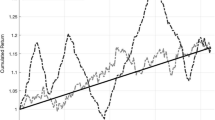Abstract
Most literature on time diversification focuses on the risks of stocks versus bonds. Little attention has been given to the impact of time horizon on the risks for value versus growth stocks. With the growing popularity of those two investment styles, it is in great need to analyze the time changing nature of risks for value versus growth styles. This article seeks to fill in the void. We study three downside risk measures: shortfall risk, expected loss and lower partial standard deviations (LPSDs), for value versus growth styles across different holding periods. We find that all the three risk measures decline when time horizon lengthens. The benefit of time diversification is greater for value stocks than for growth stocks. And value stocks outperform growth stocks in terms of both risks and returns in the long run. Does this mean that an investor should increase his/her investment in value stocks for longer investment horizons? We further explore the optimal mix of value and growth stocks across time horizons. Interestingly, even though value stocks dominate growth stocks in both risks and returns in the long run, adding growth stocks to value stocks is still beneficial. With rolling window analysis (when the returns are autocorrelated), the optimal weights for value stocks are approximately 50 per cent, 40–50 per cent and 30–40 per cent in order to minimize shortfall risk, expected loss and LPSDs, respectively, for an investment window of 1–15 years. With bootstrap analysis (return distributions are independent), the optimal weights for value stocks increase as time horizon lengthens. However, even for the 15-year window, the optimal portfolio still has about 30 per cent growth stocks. In other words, style diversification is still important even in the long run.
Similar content being viewed by others
References
Alles, L. and Murray, L. (2009) Investment performance and holding periods: An investigation of the major UK asset classes. Journal of Asset Management 10 (5): 280–292.
Balzer, L.A. (1994) Measuring investment risk: A review. Journal of Investing 3 (3): 47–58.
Bawa, V.S. (1975) Optimal rules for ordering uncertain prospects. Journal of Financial Economics 2 (1): 96–121.
Bernstein, P. (1976) The time of your life. Journal of Portfolio Management 2 (4): 4–10.
Best, R., Hodges, C.W. and Yoder, J.A. (2007) The Sharpe ratio and long-run investment decisions. Journal of Investing 16 (2): 70–76.
Bodie, Z., Kane, A. and Marcus, A. (2006) Investments, 7th edn. New York: McGraw-Hill.
Bulter, K.C. and Domian, D.L. (1991) Risk, diversification, and the investment horizon. Journal of Portfolio Management 17 (3): 41–47.
Connelly, T.J. (1996) The time diversification controversy. Journal of Financial Planning 9 (1): 20–23.
Fishburn, P.C. (1977) Mean-risk analysis with risk associated with below-target returns. American Economic Review 67 (2): 116–126.
Fortuna, P. (2000) Old and New Perspectives on Equity Risk, AIMR Conference Proceedings, February, CFA Institute, pp. 37–45.
Hanna, S. and Chen, P. (1999) Small stocks vs. large: It's how long you hold that counts. AAII Journal XXI (6): 26–27.
Hodges, C., Taylor, W. and Yoder, J. (1997) Stocks, bonds, the sharpe ratio and the investment horizon. Financial Analysts Journal 53 (6): 74–80.
Jorion, P. (2003) The long-term risks of global stock markets. Financial Management 32 (4): 5–26.
Kish, R.J. and Hogan, K.M. (2000) Small stocks for the long run. Financial Counseling and Planning 11 (2): 21–31.
Kritzman, M. (1994) What practitioners need to know about higher moments. Financial Analysts Journal 50 (5): 10–17.
Lloyd, W. and Haney, R. (1980) Time diversification: surest route to lower risk. Journal of Portfolio Management 6 (3): 5–9.
Lloyd, W. and Modani, N. (1983) Stocks, bonds, bills and time diversification. Journal of Portfolio Management 9 (3): 7–11.
Markowitz, H.R. (1959) Portfolio Selection. New York: John Wiley & Sons.
Maurer, R., Albrecht, P. and Ruckpaul, U. (2001) Shortfall risks of stocks in the long run. Financial Markets and Portfolio Management 15 (4): 481–499.
Mukherji, S. (2002) Stock, bonds, bills, wealth, and time diversification. Journal of Investing 11 (2): 39–52.
Nawrocki, D. (1999) A brief history of downside risk measures. Journal of Investing 8 (3): 9–25.
Payne, J. (1973) Alternative approaches to decision making under risk: Moments vs. risk dimensions. Psychological Bulletin 80 (6): 439–453.
Reichenstein, W. (1986) When stock is less risky than treasury bills. Financial Analysts Journal 42 (6): 71–75.
Samuelson, P. (1963) Risk and uncertainty: A fallacy of large numbers. Scientia 57 (6): 1–6.
Samuelson, P. (1969) Lifetime portfolio selection by dynamic stochastic programming. Review of Economic Statistics 51 (3): 239–264.
Siegel, J.J. (2002) Stocks for the Long Run. New York: McGraw-Hill.
Sortino, F. and Satchell, S. (eds.) (2001) Managing Downside Risk in Financial Markets: Theory, Practice and Implementation. Oxford: Butterworth-Heinemann Finance.
Thorley, S. (1995) The time diversification controversy. Financial Analysts Journal 51 (3): 68–76.
Author information
Authors and Affiliations
Corresponding author
Rights and permissions
About this article
Cite this article
Wang, J. Impact of investment horizon on the performance of value versus growth styles and style allocation. J Asset Manag 12, 438–446 (2011). https://doi.org/10.1057/jam.2011.20
Received:
Revised:
Published:
Issue Date:
DOI: https://doi.org/10.1057/jam.2011.20




